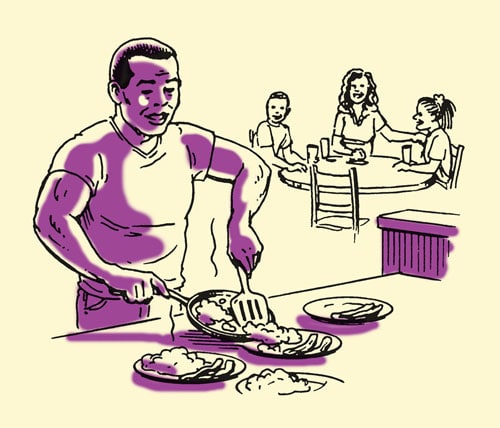
Loving relationships are the most important factor in a man’s happiness, success, and ability to live a fully flourishing life.
And one of the most important factors in creating and sustaining these warm, intimate relationships is communication.
Unfortunately, how to communicate with one’s significant other in a healthy, positive way is something rarely taught to either men or women. As a result, many couples find that their discussions regularly turn into heated, unproductive arguments that ultimately damage their relationship. Angry fighting leads to distance and weakens intimacy. Yelling, sarcasm, insults, and name-calling undermine trust. This kind of pejorative communication creates defensiveness and alienation, which makes it nearly impossible for a couple to address their issues together. What starts as a conversation escalates into a fight in which the original issue gets forgotten, you lose track of what you’re even yelling about, and nothing gets resolved.
In contrast, couples who know how to discuss their disagreements in a healthy way are able to nip problems in the bud before they turn into big, relationship-ending issues. The key to this kind of positive interaction is what the authors of Couple Skills call “clean communication.” Matthew McKay, Patrick Fanning, and Kim Paleg (hereafter referred to as MFP) define clean communication as “taking responsibility for the impact of what you say.” By being more intentional about their communication techniques and leaving out rhetoric that wounds one’s partner and creates defensiveness, a couple creates a safe place in which to honestly and respectfully work through their differences.
What are the principles of clean communication? MFP lay out 10 “commandments” to follow when you’re talking with your significant other. While the focus of this post is communication in a romantic relationship, much of this also applies to personal interactions in all areas of your life.
The 10 Commandments of Clean Communication
1. Avoid judgment words and loaded terms.
- “You’re acting so childish right now.”
- “Oh boo-hoo. I’m tired of your perpetual ‘poor me’ attitude.”
- “Maybe if you were more of a man, you’d be able to handle this.”
- “You’d probably feel better if you got off your fat, lazy ass and finally did something about it.”
When you’re having a heated argument with your significant other, it can be very tempting to level a real zinger at them – to use words and putdowns you know will wound them and push their buttons. Such zingers aim to point our their flaws and tear down their worth. They accomplish this mission – but at the expense of trust and intimacy.
2. Avoid “global” labels.
There are two ways to criticize someone – you can critique their character or their behavior. In criticizing behavior, you’re calling out something specific and temporary – something the person can realistically change. But in assailing someone’s very identity, you’re issuing a global label – a blanket condemnation of who they are at the core; they don’t just do bad stuff, they are a bad person.
Global labels can feel highly satisfying to hurl at someone when you’re angry and can seem completely justifiable at the time. In writing the person off as incorrigible, you also essentially absolve yourself of any responsibility for your issues as a couple: “We wouldn’t have this problem if you weren’t so selfish.”
But blanket condemnations of your partner’s character are anathema to a loving relationship. They will make her feel hurt and defensive, greatly hindering any chance of communication. Global labels also make your partner feel helpless – if the problem is rooted in their very identity/personality, changing will seem impossible to them. They’re liable to answer: “I’m sorry, but this is the way I am!” Thus, in using global labels you wash your hands of any responsibility for the problem, while at the same time, your partner will feel unable and unwilling to do anything about it either…not a recipe for effective conflict resolution!
Here are some examples of global labels, and how they could be better rendered as specific critiques of behavior instead of character:
- “You’re so self-centered and only care about yourself.” → “In forgetting my birthday, I felt like you didn’t think about my feelings.”
- “You’re such a bitch.”→ “Questioning my masculinity is a low-blow. I’d like to try to talk to you without the name-calling.”
- “You’re always so helpless.” → “I know you’re having trouble figuring out how to download that app, but right now I need to finish this paper. If you still can’t get it, I promise to help you tonight.”
3. Avoid “you” messages of blame and accusation.
As MFP put it, “the essence of a ‘you’ message is simply this: ‘I’m in pain and you did it to me.’ And there’s usually this subtext: ‘You were bad and wrong for doing it to me.’” When people slight us, it may be true that they are entirely, or almost entirely, to blame. But when you lead with that blame, the instigator will instantly erect walls of defensiveness that will make working through the issue together impossible. This doesn’t mean you have to pretend your significant other is not at fault when they are, it just means you use language that says the same thing in a different way – couching your message so that it actually has a chance to surmount their psychological walls and reach their brain.
To do this, you want to swap out your you-centered accusations for statements that emphasize “I” – how you feel when your partner does certain things. Here are some examples:
- “You always leave the house such a mess.” → “When the house is so cluttered I end up feeling stressed out.”
- “Your moodiness is ruining our relationship.” → “When I can’t predict your moods, I’m not sure how to approach you, and I feel like that’s eroding the intimacy in our relationship.”
- “You’re always late and it’s driving me crazy.” → “I feel embarrassed when we arrive late to events.”
4. Avoid old history.
- “You’re just being ungrateful like always. Remember when I spent all weekend cleaning the house before your folks arrived and you never even said thank you?”
- “You don’t trust me? At least I’m not the one who cheated last year.”
- “It’s always the same damned thing with you. You’re sorry about spending too much on the couch, just like you were sorry for going over budget on the kitchen remodel, and sorry for spending so much on the dress for our wedding…”
When you’re addressing a certain problem, stick with the issue at hand instead of slinging mud, or engaging in what my friend calls “closet-fighting” — i.e., reaching back into the closet of your past for old grievances to buttress your current accusations. When we closet-fight, MFP write, “The message is: ‘You’re bad, you’re bad, you’re bad. You’ve always had this flaw, and it’s not getting any better.'” While talking about your history together may be useful when you’re both calm, MFP recommend sticking to the present when things are heated, as “anger turns references to the past into a club rather than a source of enlightenment.”
Resurrecting old beefs will ratchet up the intensity of your discussion, and will invariably send it off in a different direction and away from resolving the original issue. Plus, your partner will likely be hurt that you’re still holding onto something she thought you’d forgiven her for, and you both will feel like your relationship isn’t progressing. It’s hard to move forward if you keep rehashing the past; instead, let sleeping dogs lie.
5. Avoid negative comparisons.
- “You’re so irrational, just like your mom.”
- “None of my exes were ever as clingy as you are.”
- “Why can’t you be more fun like Derek’s girlfriend is?”
Being compared negatively to someone else sure can sting. We oftentimes want to think we’ve evolved past the flaws of our parents, so to hear “you’re just like your dad” feels like a punch to the gut. So too, our identities are very much based on comparing ourselves to our peers, and to have the person we love say we don’t stack up to them cuts at our sense of worth. Making negative comparisons also tells your partner that you’ve been thinking about someone else, and how that other person measures up to her, which can provoke hurt feelings and jealously.
6. Avoid threats.
- “If you’re going to act like that, then I’m not going with you to your parents’ house this weekend.”
- “If you can’t get your act together, then maybe we should get a divorce.”
- “If you don’t want to be more adventurous in bed, I can find plenty of other women who are willing to be.”
MFP write that “the basic message of a threat is: you’re bad and I’m going to punish you.” It’s a way of trying to compel desired behavior, but since it shuts down the whole discussion, even if it works in the short term, the underlying issue will remain unresolved. If your partner complies, she’ll only be doing it to avoid the consequences of your threat, and if she doesn’t, the argument is going to escalate and/or keep reoccurring.
There is a place for quasi-ultimatums in a relationship, but they come after you’ve completely exhausted every attempt to communicate and compromise about the problem in a positive way. Too often people resort to a threat as an easy way to resolve things, and will even drop the D word to scare their spouse into compliance.
An “or else” statement shouldn’t be thrown around, and it shouldn’t be punitive. That is, if your partner is unwilling to meet your needs, create a plan to meet those needs yourself, but don’t do so in a way that’s specifically designed to punish your partner. So for example, if you want to spend more time with friends, but your significant other won’t budge on giving her blessing, you might say, “I’m going to start spending every Saturday morning with them,” and then follow through on that action. A punitive ultimatum, on the other hand, would be something like deciding to skip out on a concert you agreed to attend with her, in order to do something with your buddies.
Your partner may come to accept the implementation of your ultimatum or it may drive a wedge in your relationship. If the latter, it may spell the end; clean communication offers the best possible chance of relationship success, but doesn’t guarantee it if you just aren’t right for each other.
7. Describe your feelings rather than attack with them.
Your demeanor can truly be wielded like a weapon. When we raise our voice, withdraw into cold hostility, adopt a sneering tone, or employ biting sarcasm, we can wound those we love. Especially when it comes to communicating with women, you would be surprised how a cutting tone of voice can make them feel almost physically hurt. Instead, do your best to keep your voice level and calm.
As you discuss what’s bothering you, describe your emotions as specifically as possible. “In so doing,” MFP write, “your partner can hear what you’re feeling without being overwhelmed or bludgeoned by it.” Here are some examples:
- “I feel disrespected when you make jokes at my expense when we’re out with your friends.”
- “I feel jealous when I see you texting your ex.”
- “I feel hurt when you ignore me when I come home from work.”
8. Keep body language open and receptive.
Even more than what we say, our body language conveys how we’re actually feeling. You may tell your significant other that you’re not angry and are willing to talk things through, but if your posture and facial expressions say otherwise, they will assuredly pick up on it. They’ll also likely match your defensive stance, and the discussion will get off to a rocky start.
To keep things amicable, adopt an open, rather than closed posture. Folding your arms, tensing your jaw, squinting, looking disgusted, balling up your fists, fidgeting in an irritated way, and rolling your eyes are all behaviors that make you seem closed off, hostile, and unwilling to communicate. Create sincere, inviting body language by relaxing your face, making warm eye contact, leaning forward, keeping your arms uncrossed, and nodding to show you’re listening.
9. Use whole messages.
Oftentimes, you may think you’re getting your message across to your significant other, but the result is a big miscommunication. They hear something much different than you intended. What we say makes total sense to us, because we have the entire context of it in our heads. But what actually comes out of our mouths may only be a slice of that bigger picture – a partial fragment that is then misconstrued by our partner.
To avoid this, strive to deliver “whole messages” when speaking with your significant other. Whole messages consist of 4 parts:
- Observations: “Observations are statements of fact that are neutral, without judgments or inferences,” write MFP. “The house is a mess,” vs. “I’ve noticed you’re a slob.”
- Thoughts: MFP describe this component as “your beliefs, opinions, theories, and interpretations of a situation. Thoughts are not conveyed as absolute truth but as your personal hypothesis or understanding of a situation. ‘My idea was…I wondered if…I suspected that…I worried that…The way I saw it was…’”
- Feelings: Describe your feelings in a specific way that doesn’t blame your partner. “I’m concerned about our budget,” vs. “Your spending is out of control and really stressing me out.”
- Needs/Wants: Too often we expect our partner to be mind readers, but as MFP note, “No one can know what you want unless you tell them.” For an in-depth guide to expressing your needs in a relationship, check out this post.
Here’s an example of a whole message:
“We haven’t been spending as much time together [Observation]. It seems like you’ve been busier, and I don’t know if that’s just because your classes are hard this semester or you just haven’t been as interested in hanging out [Thoughts]. I’ve been feeling distant from you and confused about the status of our relationship [Feelings]. I’d like for us to be more committed as a couple and to know what you think about the future of our relationship [Needs].”
10. Use clear messages.
Just as a partial message can be misconstrued, so too can a “contaminated” message. This occurs when you mix some of the 4 elements together or “mislabel” them in order to disguise your real intent. Your partner might say, “Hmmm, that’s an interesting way to do it,” when they really mean, “You’re doing it wrong.” Or for example, you might say to your wife, “And here you are finally, late as usual.” You’re pretending to make a straightforward observation, but you’re really mixing in your judgments, thoughts, and feelings. It would be better to say, “I’ve been waiting here for 20 minutes. It seems like you struggle to be on time. When I’m left waiting I end up feeling frustrated and disrespected. Do you think you could make more of an effort to be on time?”
MFP note that one “effective way to contaminate your message is to disguise it as a question”:
- “Why didn’t you take out the trash last night?”
- “Is there a reason all the dishes have been left in the sink?”
- “Why don’t you take our finances more seriously?
- “Do you really think that’s a good idea?”
The questioner adopts the posture of soliciting information from their partner, but they already know the answer and their feelings about it; they’re really just making an accusation and showing their disapproval for their partner’s choice. To be honest, it seems like women do this more than men (sorry ladies), perhaps because they’re often less comfortable being assertive.
Muddy messages create distance and contention in a relationship. Your partner either will not be sure what you’re driving at, or will take umbrage at your not simply saying what you mean. Give it to ‘em straight, and give it to ‘em cleanly.
________________________
Source:
Couple Skills by Matthew McKay, Patrick Fanning, and Kim Paleg. I read through a bunch of relationship advice books recently looking for some good bits that might be helpful to pass along to readers. This was definitely the best in the bunch. It’s written by men (one of which runs a men’s support group) and includes lots of concrete, useful, practical tips.














